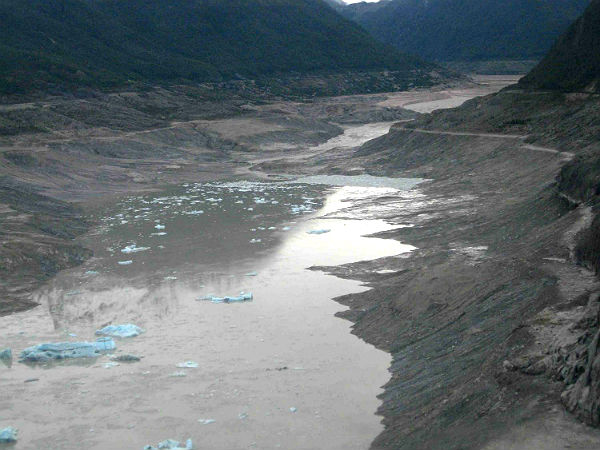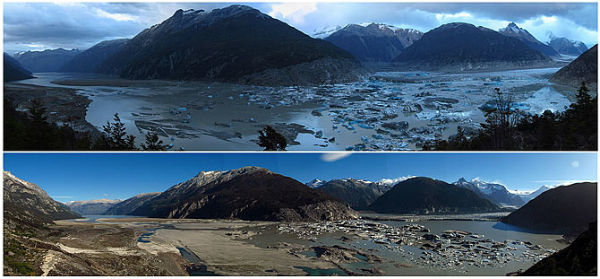Chile’s Lake Cachet II vanished in less than 24 hours

Lake Cachet II in Chile’s southern Patagonia vanished in less than 24 hours, leaving behind just some large puddles and chunks of ice in the vast lake bed. Lake Cachet II’s 200 million cubic liters of water gushed out into the Baker river, tripling its volume and emptying the five square kilometer (two square miles) lake bed. Cachet II has drained 11 times since 2008. The people living beside the Colonia River in the Aysén region of Chilean Patagonia are under constant threat of a sudden catastrophic flood sweeping down from the mountains above them. With trend of rising global temperatures, experts believe this will increase in frequency.
Melting of Colonia Glacier is responsible for lake’s water inflow. It is located in the Northern Patagonian ice field, some 2,000 kilometers (1,250 miles) south of the capital, Santiago. The glacier normally acts as a dam containing the water, but rising temperatures have weakened its wall. Twice this year, on January 27 and March 31, water from the lake bore a tunnel between the rocks and the glacier wall which resulted with disappearing water. In March, the lake dropped 31 meters (90 feet) when the water drained out, according to a report from the General Water Directorate, which monitors lake levels in Chile using satellite data.

This phenomenon is known as GLOFs (Glacial Lake Outburst Floods).
Glacial lake outburst flood (GLOF) is a type of outburst flood that occurs when the dam containing a glacial lake fails. The dam can consist of glacier ice or a terminal moraine. Failure can happen due to erosion, a buildup of water pressure, an avalanche of rock or heavy snow, an earthquake or cryoseism, volcanic eruptions under the ice, or if a large enough portion of a glacier breaks off and massively displaces the waters in a glacial lake at its base.
Climate models predict that as temperatures rise, it will become more frequent. The global climatic change during the first half of the twentieth century has brought a tremendous impact on the high mountainous glacial environment. Many of the big glaciers melted rapidly and gave birth to the origin of a large number of glacier lakes. Due to the faster rate of ice and snow melting, possibly caused by the global warming, the accumulation of water in these lakes has been increasing rapidly and resulting sudden discharge of large volumes of water and debris and causing flooding in the downstream. Glacial lake outburst flood (GLOF) causes disasters to life and property along the downstream, results serious death tolls and destruction of valuable forests, farms and costly mountain infrastructure.
The GLOF phenomenon is not exclusive to Patagonia: it has happened in places like the Himalayas, and in Iceland due to volcanic activities. In a phenomenon also related to rising temperatures, a slab of ice the size of a city block broke off Peru’s Hualcan glacier and slid into a high mountain lake with destructive consequences in April 2010. The crash unleashed a giant wave that breached the lake’s levees, causing a tsunami of mud on a village in the northern province of Carhuaz that destroyed more than 20 homes and leaving some 50 people homeless, according to regional Civil Defense.
According to a 2009 World Bank report, in the last 35 years, Peru’s glaciers have shrunk by 22%, leading to a 12% loss in the amount of fresh water reaching the coast. There are a number of imminent deadly GLOFs situations that have been identified worldwide. The Tsho Rolpa glacier lake in the Rolwaling Valley, about 110 kilometres (68 mi) northeast of Kathmandu, Nepal, is growing larger every year due to the melting and retreat of the Trakarding Glacier, and has become the largest and most dangerous glacier lake in Nepal, with approximately 90 to 100 million m³ (117 to 130 million yd³) of water stored.
Sources: RRCAP/UNEP, Wikipedia, TerraDaily, Glacier Change
Featured image credit: GlacierChange


We all need to improve our “golf” swings.
What may confuse some people is that they see in one particular area that temperatures are actually dropping in part due to the break up of the Golf stream or wind pattern that are changing due to climate changes. The golf stream for instance can be disturbed by altering the gravity of the water which is happening due the increase in water levels caused by the melting of ice. This in turn can cause a mini ice age over Europe and North America while the rest of the globe will warm up further leaving us with overall higher average global temperatures until the systems have balanced them self out again.
This balancing out may take a few centuries or millennia depending how fast the greenhouse gases can be absorbed and how fast humanity will be reduced in numbers as well as how fast we stop polluting all the while cleaning up past and present pollutions we caused.
Denying the human impact on our ecosystems and climate all the while rejecting our responsibility in this matter is like denying the holocaust every happened.
warming again, sigh.. try as stated inflow of water, a natural event, and some subsidence of already wet and weak soils.
in case you havent been looking at any Non ipcc warmist hype sites? the global temps dropping, and a hell of a lot of glaciers are growing again.
According to NASA, the IPSS, and Universities such as the University of Tokyo all are saying that “average temperatures have climbed 1.4 degrees Fahrenheit (0.8 degree Celsius) around the world since 1880, much of this in recent decades, according to NASA’s Goddard Institute for Space Studies.
• The rate of warming is increasing. The 20th century’s last two decades were the hottest in 400 years and possibly the warmest for several millennia, according to a number of climate studies. And the United Nations’ Intergovernmental Panel on Climate Change (IPCC) reports that 11 of the past 12 years are among the dozen warmest since 1850.”
[…] Lake Disappears https://watchers.news/2012/05/23/chiles-lake-cachet-ii-vanished-in-less-than-24-hours/ […]